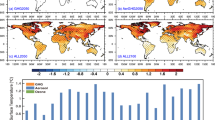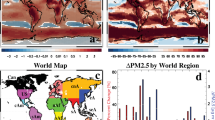Abstract
Atmospheric aerosols are of significant environmental importance, due to their effects on air quality, as well as their ability to alter the planet’s radiative balance. Recent studies characterizing the effects of climate change on air quality and the broader distribution of aerosols in the atmosphere show significant, but inconsistent results, including the sign of the effect1,2,3. Using a suite of state-of-the-art climate models, we show that climate change is associated with a negative aerosol–climate feedback of −0.02 to −0.09 W m−2 K−1 for direct radiative effects, with much larger values likely for indirect radiative effects. This is related to an increase in most aerosol species, particularly over the tropics and Northern Hemisphere midlatitudes, largely due to a decrease in wet deposition associated with less large-scale precipitation over land. Although simulation of aerosol processes in global climate models possesses uncertainty, we conclude that climate change may increase aerosol burden and surface concentration, which may have implications for future air quality.
This is a preview of subscription content, access via your institution
Access options
Subscribe to this journal
Receive 12 print issues and online access
$209.00 per year
only $17.42 per issue
Buy this article
- Purchase on Springer Link
- Instant access to full article PDF
Prices may be subject to local taxes which are calculated during checkout



Similar content being viewed by others
References
Dawson, J. P., Adams, P. J. & Pandis, S. N. Sensitivity of PM2.5 to climate in the Eastern US: A modeling case study. Atmos. Chem. Phys. 7, 4295–4309 (2007).
Jacob, D. J. & Winner, D. A. Effect of climate change on air quality. Atmos. Environ. 43, 51–63 (2009).
Pye, H. O. T. et al. Effects of changes in climate and emissions on future sulfate–nitrate–ammonium aerosol levels in the United States. J. Geophys. Res. 114, D01205 (2009).
Held, I. M. & Soden, B. J. Robust responses of the hydrological cycle to global warming. J. Clim. 19, 5686–5699 (2006).
Yin, J. H. A consistent poleward shift of the storm tracks in simulations of 21st century climate. Geophys. Res. Lett. 32, L18701 (2005).
Bengtsson, L., Hodges, K. I. & Roeckner, E. Storm tracks and climate change. J. Clim. 19, 3518–3543 (2006).
Vecchi, G. A. & Soden, B. J. Global warming and the weakening of the tropical circulation. J. Clim. 20, 4316–4340 (2007).
Seidel, D. J., Fu, Q., Randel, W. J. & Reichler, T. J. Widening of the tropical belt in a changing climate. Nature Geosci. 1, 21–24 (2008).
Chang, E. K. M., Guo, Y. & Xia, X. CMIP5 multimodel ensemble projection of storm track change under global warming. J. Geophys. Res. 117, D23118 (2012).
Racherla, P. N. & Adams, P. J. Sensitivity of global tropospheric ozone and fine particulate matter concentrations to climate change. J. Geophys. Res. 111, D24103 (2006).
Avise, J. et al. Attribution of projected changes in summertime US ozone and PM2.5 concentrations to global changes. Atmos. Chem. Phys. 9, 1111–1124 (2009).
Kirtman, B. et al. in Climate Change 2013: The Physical Science Basis (eds Stocker, T. F. et al.) 953–1028 (IPCC, Cambridge Univ. Press, 2013).
Ackerley, D., Highwood, E. J., Frame, D. J. & Booth, B. B. B. Changes in global sulfate burden due to perturbations in global CO2 concentrations. J. Clim. 22, 5421–5432 (2009).
Kloster, A. et al. A GCM study of future climate response to aerosol pollution reductions. Clim. Dynam. 34, 1177–1194 (2010).
Fang, Y. et al. The impacts of changing transport and precipitation on pollutant distributions in a future climate. J. Geophys. Res. 116, D18303 (2011).
Carslaw, K. et al. A review of natural aerosol interactions and feedbacks within the Earth system. Atmos. Chem. Phys. 10, 1701–1737 (2010).
Raes, F., Liao, H., Chen, W.-T. & Seinfeld, J. H. Atmospheric chemistry-climate feedbacks. J. Geophys. Res. 115, D12121 (2010).
Liao, H., Zhang, Y., Chen, W. T., Raes, F. & Seinfeld, J. H. Effect of chemistry-aerosol-climate coupling on predictions of future climate and future levels of tropospheric ozone and aerosols. J. Geophys. Res. 114, D10306 (2009).
Bellouin, N. et al. Aerosol forcing in the Climate Model Intercomparison Project (CMIP5) simulations by HadGEM2-ES and the role of ammonium nitrate. J. Geophys. Res. 116, D20206 (2011).
Boucher, O. et al. in Climate Change 2013: The Physical Science Basis (eds Stocker, T. F. et al.) 571–658 (IPCC, Cambridge Univ. Press, 2013).
Lamarque, J. F. et al. The Atmospheric Chemistry and Climate Model Intercomparison Project (ACCMIP): Overview and description of models, simulations and climate diagnostics. Geosci. Model Dev. 6, 179–206 (2013).
Shindell, D. T. et al. Radiative forcing in the ACCMIP historical and future climate simulations. Atmos. Chem. Phys. 13, 2939–2974 (2013).
Taylor, K. E., Stouffer, R. J. & Meehl, G. A. An overview of CMIP5 and the experiment design. Bull. Am. Meteorol. Soc. 93, 485–498 (2012).
Myhre, G. et al. in Climate Change 2013: The Physical Science Basis (eds Stocker, T. F. et al.) 659–740 (IPCC, Cambridge Univ. Press, 2013).
Acknowledgements
We acknowledge the climate modelling groups participating in the Atmospheric Chemistry and Climate Model Intercomparison Project (ACCMIP) for producing and making available their model output, and the World Climate Research Programme’s Working Group on Coupled Modelling, which is responsible for CMIP. For CMIP the US Department of Energy’s Program for Climate Model Diagnosis and Intercomparison provides coordinating support and led development of software infrastructure in partnership with the Global Organization for Earth System Science Portals.
Author information
Authors and Affiliations
Contributions
R.J.A. conceived the project, designed the study, carried out the data analysis and led the writing of the paper. W.L. assisted in writing of the paper. S.T.R. provided un-archived HadGEM2 data. All authors discussed the results and commented on the manuscript.
Corresponding author
Ethics declarations
Competing interests
The authors declare no competing financial interests.
Supplementary information
Rights and permissions
About this article
Cite this article
Allen, R., Landuyt, W. & Rumbold, S. An increase in aerosol burden and radiative effects in a warmer world. Nature Clim Change 6, 269–274 (2016). https://doi.org/10.1038/nclimate2827
Received:
Accepted:
Published:
Issue Date:
DOI: https://doi.org/10.1038/nclimate2827
This article is cited by
-
The projected future degradation in air quality is caused by more abundant natural aerosols in a warmer world
Communications Earth & Environment (2023)
-
Scattering and absorbing aerosols in the climate system
Nature Reviews Earth & Environment (2022)
-
Disproportionate control on aerosol burden by light rain
Nature Geoscience (2021)
-
Weakening aerosol direct radiative effects mitigate climate penalty on Chinese air quality
Nature Climate Change (2020)
-
A likely increase in fine particulate matter and premature mortality under future climate change
Air Quality, Atmosphere & Health (2020)



